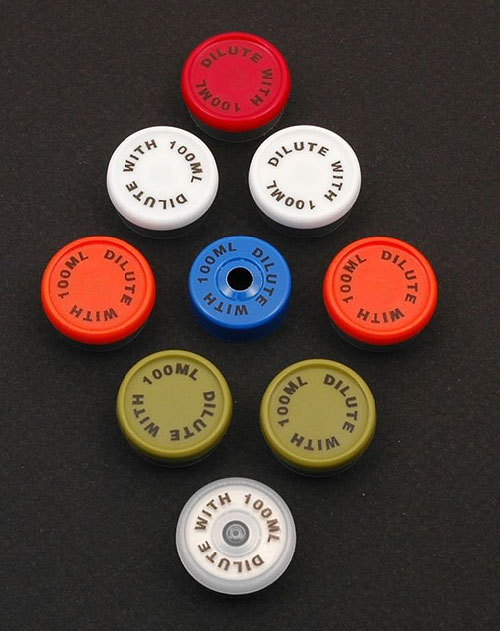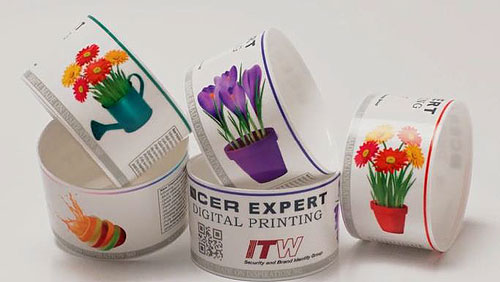Why Invest in Digital Decoration?
by Chris DeMell
ITW Security and Brand Identity

Digital decoration provides flexibility and increased throughput, and opens the door for short lead times and a very efficient production facility.
There are three main drivers spurring the transition to digital decoration. These "three pillars" focus on finance, operations and marketing.
The financial drivers stem from the ongoing emphasis on cost cutting. Digital printers typically require less labor (fewer operators) than pad printing or screen printing operations. Improved flexibility and efficiency allow for direct labor savings while freeing up operators for use elsewhere in the facility. The non-contact nature of digital decoration also results in a significant reduction in consumables. Plates, clichés, pads, screens, solvents, labels, transfers, doctor blades and many other supplies required for analog processes no longer are needed with digital printing. This greatly reduces the direct cost of the consumables, as well as the indirect cost of stocking these products – inventory.
Digital printing can make the transition from job-to-job with the click of a button. Images literally can be changed from part to part, facilitating variety as well as small production runs. Analog decoration methods are most efficient for long runs. To meet customer demands, inventories of specific products have to be held at a punitive cost to the company. The just-in-time nature of digital technology allows companies to lower the amount of finished goods inventories on hand as they now can be decorated on demand.
From an operations perspective, digital decoration provides flexibility and increased throughput for small production quantities. Analog systems are optimal for long runs utilizing the same or constant image. However, if a company has multiple images for a variety of products, analog systems become cumbersome and costly. Changeover with digital is done in seconds, opening the door for short lead times and a very efficient production facility.
Finally, marketers love the virtually limitless capability that digital now offers. Customization and personalization have found their way to the mainstream of retail products. Marketers are looking to narrow the focus of product decoration from the macro arena of geographic or cultural targeting to the local and individual level. Variable data, such as sequential numbering and individual barcodes, also add value to product offerings. Digital printers typically use process color decoration, which provides for tens of thousands of colors, all from the same system. Logos no longer are limited to a few colors as companies now can print anything up to full photographic images.
How has the digital business evolved?
Piezo-based digital printers have been around for over 30 years; as a result, the overall technology is very well known. The foray into industrial decorating still is relatively new, having the first major inroads in the past six years. As would be expected, the first systems used were standard digital flatbed printers. As long as products were perfectly flat and less than an inch tall, they could be fixtured on the bed.
The success of the initial systems in opening up new markets in the industrial arena spurred companies to develop custom systems designed for unique applications. The industrial market throughput demands inspired the introduction of the first single pass, continuous printers that were paired with automation. In this "early adopters" phase of the system, there still were many unknowns pertaining to the unique challenges of the industrial market.
Through gained experience, and in some cases, trial and error, markets developed specific configurations and technology. Some examples include printing textiles and ceramics. Each of these has a massive footprint on the overall market share of industrial decoration. Specific printhead technology has been developed by companies such as Xaar and Dimatix to meet the tremendous market potential. Ink manufacturers developed specific chemistries geared to meet the unique, specific market requirements.
As the "market-specific" approach continues to effect system design, companies have introduced systems designed directly for industrial part decoration. Flatbed printers have made accommodations to allow for a much greater height of product, up to 24" in some cases. Systems are being built with the idea that they will be placed in production environments rather than in clean print rooms. Continuous systems are designed to improve throughput and maintain quality control. Digital decoration has created a paradigm shift in the decoration business and will continue to grow and impact how companies approach their markets.
What are the unique challenges that industrial decoration presents?
Operating in the industrial arena has introduced a variety of challenges for digital decorating systems. The key impacts have been seen in substrate variability, adhesion and durability requirements, throughput needs, regulatory adherence and operating environments.
The substrate variability issue ties in directly with adhesion and durability. The industrial digital decoration printers primarily are UV-based systems. UV inks cure as a polymeric film, which does allow for fairly good resistance to fade, UV exposure and chemical resistance. The difficulty lies in the fact that fluids have to work across a broad spectrum of products including glass, wood, powder coat, paint, metals and a full range of plastics. Each substrate reacts differently to UV fluids and may require a treatment to obtain full adhesion. Flame and plasma offer very good results in obtaining the proper dyne level for optimal adhesion; however, substrates such as glass and metal offer unique challenges. For these, a jettable or hand-applied primer may be needed. Industrial standards often require very specific tests for adhesion and durability as well. ASTM cross hatch and tape testing really are baseline tests. Industrial applications require the reality of a scratch test, chemical rub downs and typically some type of abrasion testing. To address these, digital ink manufacturers have been developing both broad range fluids that work across the board and product-specific formulations, such as inks that work with polypropylene without treatment. Additional products – jettable primers and clear coat fluids – have been developed to address harsh testing required for this market.
The industrial environment plays a significant role in the design of digital decorating systems. Temperature fluctuations, dust, humidity and even lighting can have a direct effect on the performance and maintenance of equipment. Equipment is specially designed with robust construction and guarding to optimize performance in harsh environments. Automation is incorporated where possible to maximize the throughput in these conditions, while turn-key approaches are available for cell environments.
Regulations designed for pad printing, labels, screen and others now are being applied to the digital decorating process. BPA-free, heavy metal content and toy compliance are just a few common requirements for industrial fluids. Each market has specific requirements, such as Medical Class VI for medical applications, which are available for the new industrial markets.
What limitations does digital printing have when compared to traditional analog technologies?
Digital decoration has gained a considerable foothold in product decoration; however, there are limitations which exist that restrict its use in some cases. First, the piezo-based systems have limitations to the extent of curvature that can be handled with standard systems. A typical piezo head can handle anywhere from .5mm to 5mm, depending on the technology. Most systems have been touted as "Flat to Near Flat" printers. To improve upon this, companies have looked to new printhead technologies that have greater jetting velocity to improve throw distance. Wave forms can be worked on to enhance jetting capabilities as well. Digital has several variables that can be adjusted to deal with more complex substrates; however, there still are overall limitations to the amount. Automation and robotics also are used to address complex shapes by manipulating the part rather than heads to increase the amount of exposure to the printable surface.
Fluid availability and options also limit full capability. Pad and screen, for example, have been around for decades. There are hundreds of options from spot colors, metallic and fluorescents to pearlescent and full functional fluids. A limiting factor for piezo fluids is that the particulates that go into them have to be sub-micron. This creates challenges for the ink manufacturers that also have to ensure the fluid is of proper viscosity and can be jetted with the appropriate technology. As the markets continue to grow, more and more options have become available. Spot colors are being added to an industry that focused exclusively on process color printing. Clear fluorescents, conductive fluids, metallic and many other options now are available or being developed. As the availability increases, the more industry will turn to the flexibility and advantages of the technology.
Where is this all heading?
Industrial decoration has a very bright future and continually is being challenged to come up with new solutions for unique markets. Software, engineering and technology are being synced to achieve outputs that to date were not previously possible. One example of this is full cylindrical printing. Systems now exist to print 360 degrees at reasonably fast rates to meet production demands. The real challenge, the "Holy Grail" of digital decoration, is printing fully complex curvatures at production speeds. Printing on a flat compact is fairly straight forward. Printing on a cylinder requires improved software and a precise piece of handling equipment, but is achievable today. More complex products, such as diamond shapes and tubes, also are now being printed. A complex curvature will remain a stretch goal for the near future; however, the overall capabilities will continue to grow and offer solutions that were not achievable in a cost-effective manner before.
Fluid manufacturers now are seeing the market in a new light as volumes continue to increase. Research is being done in both UV and solvents to offer this market products to meet all of the challenges they face. Digital decoration is here to stay!

